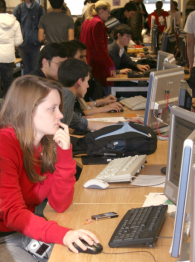
About the Project
This project is one of the 2011 WISE Awards finalists.
Synote’s aim is to transform and enhance learning, motivation, enjoyment and equality of access from recorded lectures or any audio or video teaching or learning materials. Synote has been developed to overcome the problem that, while users can easily bookmark, search, link to, or tag the whole of a podcast or video recording available on the web, they cannot easily find, or associate their notes or resources with, part of that recording.
As an analogy, users would clearly find a textbook difficult to use if it had no contents page, index or page numbers. Without the interactivity offered by Synote, students watching educational videos can go into “movie mode” and lean back with their popcorn and Coca Cola, expecting just to be entertained.
Context and Issue
Synote also enables students and teachers to pose questions and provide answers and feedback at appropriate and critical moments in recorded presentations and practical or group tasks to address the issues that it is normally very difficult and time-consuming to assess. It also provides feedback on critical moments of student presentations or practical or group tasks and evidence of students’ contributions to a group, or to interactions in large lectures.
Synote is being used by universities worldwide to transform education and enhance learning, assessment, motivation, enjoyment and equality of access from recorded lectures or any audio or video teaching or learning materials through its ability to provide synchronized transcripts, notes and annotations.
Solution and Impact
Synote is a unique, innovative and free web application that uses synchronized transcripts and notes to transform and enhance learning, motivation, enjoyment and equality of access from recorded lectures or any audio or video teaching materials. The innovation lies in the fact that the project uses speech recognition to synchronize audio, video, screen capture and narrated PowerPoint recordings of lectures or teaching or learning material with a transcript, slide images and student- or teacher-created notes or tags.
The provision of text captions and images synchronized with audio and video enables all their communication qualities and strengths to be available as appropriate for different learning styles, learning preferences and learning differences. Synote’s synchronized transcripts enable the recordings to be searched while also helping non-native speakers, deaf and hearing-impaired students to understand the spoken text.
In terms of impact, Synote has been shown to improve students’ learning, attention, motivation, efficiency, enjoyment, results and notetaking. The use of text descriptions and annotations of video or images helps blind or visually impaired students. The verbatim synchronized transcript enables students (e.g. dyslexic people) to concentrate on learning and take only brief synchronized notes.
Synote has been used by staff and students with a wide range of abilities and disabilities in schools, colleges and universities in the UK, USA, Canada, Australia, Germany, Austria, Italy and Pakistan, and feedback from users has continued to inform Synote’s design and development.
Future Developments
From originally being a project supported solely by the project team, Synote is now part of the mainstream provision at the university supported by the institution. Professional manual captioning is time-consuming and therefore expensive. The collaborative editing system that has been developed for Synote enables anyone anywhere in the world with Internet access to correct errors simultaneously in the speech recognition transcript. The tool stores all the edits of all the users and uses a matching algorithm to compare users’ edits to check if they are in agreement. New Mobile and Second Screening versions of Synote are being developed.
Synote’s continuing viability is ensured as there are no problems of bandwidth or data storage for the Synote server since only text and synchronization points are stored on the Synote server, while the recordings and images can be hosted by Synote users anywhere on the web. The use of speech recognition captioning with the facility for collaborative editing of speech recognition errors provides a sustainable and viable approach to transcription as manual captioning of recorded lectures can be prohibitively expensive. New Mobile and Second Screening versions of Synote are being evaluated.